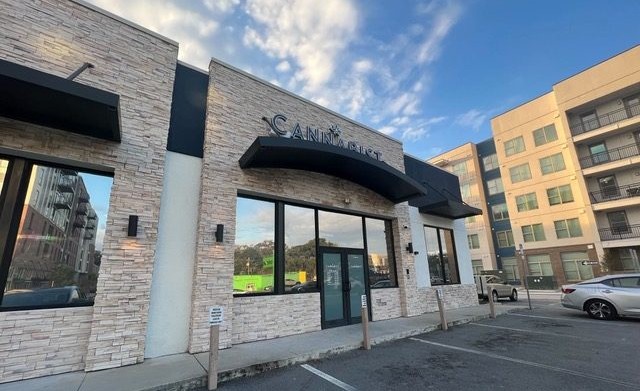Imagine you are walking home from the last day of school before spring break. You plop on your bed, kick off your shoes and take a sigh of relief. No school for a week. At least that is what Tatiana Tipton and the class of 2020 thought.
Not only did COVID-19 unleash a virus that affected the entire globe, but the growing pandemic also triggered an epidemic of anxiety and depression among America’s Generation Z and millennial populations. And many people turned to cannabis, as opposed to prescribed medication, to calm their minds.
In 2021, cannabis sales increased to $30 billion, 40% higher than the previous year. The United States is expected to make up 75% of global cannabis sales in 2026.
“I believe that cannabis has been more effective in fighting my anxiety and depression,” Tatiana Tipton said. Tipton is a third-year computer science major at the University of Florida, who began her freshman semester in the middle of the pandemic in August 2020.
“I am diagnosed with ADHD, anxiety, depression, insomnia and obsessive-compulsive disorder,” Tipton said. “After the pandemic hit, I discussed getting my medical card with my psychiatrist.”
Anxiety can have a positive correlation with attention deficit hyperactivity disorder (ADHD), as the two share symptoms.
With the prevalence of anxiety and depression seeing a 25% increase following the coronavirus pandemic, more young adults are searching to find methods of treatment.
“Going into college and being in a new place, I definitely had a lot of anxiety,” Tipton said. “I also suffer from severe insomnia, and both of those things together kind of screwed up all of my sleep schedules. I got a medical card to help me through my anxiety and sleep problems.”
According to a 2020 study, Generation Z and millennials together make up over 50% of the national medical and recreational cannabis market. On a smaller scale, insomnia and depression were the most common symptoms reported by medical marijuana cardholders followed by chronic pain and anxiety, according to a Florida study.
Daniela Ifju, a fourth-year criminology major at UF, said she suffers from obsessive-compulsive disorder (OCD), ADHD, anxiety, persistent depressive disorder, and major depressive disorder.
Her path to obtaining her medical marijuana card followed a similar line of events as that of Tipton.
“I got diagnosed with anxiety, depression and OCD in 2020 after the pandemic hit,” Ifju said. “I was talking to my psychiatrist about how cannabis really helps me establish peace and relax at night, and she said she did not see why it could not be used for medicinal purposes. She wrote me a letter of recommendation to get my medical card.”
Both Tipton and Ifju have been prescribed medications specific to their individual diagnoses, but the common denominator between them was the debilitating feeling their prescribed medications had on them. Because of the combination of diagnoses and medications they both experience, it can be challenging to find the right balance of medication types, or precisely tend to every need.
“I just don’t like my anxiety and depression medication because they make me feel like a zombie,” Tipton said.
Selective serotonin reuptake inhibitors (SSRIs) are typically the class of drug prescribed to individuals who suffer from major depressive disorder and anxiety disorders.
Joseph “JP” Orallo is a nurse practitioner at Baptist Primary Care in Jacksonville. He has an extensive background in pulmonary medicine and experience in intensive care units.
“SSRIs take four to six weeks to absorb within the body,” Orallo said. Within that adaptation period, patients can feel sluggish or “zombie-like,” he said.
However, as referenced earlier, patients who struggle with multiple diagnoses can have a harder time finding the right combination.
“When you have ADHD medication on board as a stimulant and you suffer from anxiety, it can send your anxiety levels out of whack,” Orallo said. “A way to combat this is to increase your depression medication.”
But increasing the dosage of depression medications takes the body another four to six weeks to adjust, Orallo said. This will result in another “zombie-like period.”
While there are depression medications that have anti-anxiety qualities, they still come with the potential side effects of decreased sex drive, increased nausea and weight gain.
“Weed is the alternative,” Orallo said. “The long-term use of weed is still pointing toward dementia, but I have patients who suffer from dementia who still use cannabis because it calms them down.”
Both Tipton and Ifju said cannabis has been a beneficial alternative solution to the effects of their ADHD and ADHD medications.
“Before I was able to be prescribed medicine for ADHD, weed helped me do school work because I could slow down my thought processes,” Ifju said. “Now, when I take my ADHD medication, I use cannabis to combat the increase in anxiety the medication makes me feel.”
Tipton experienced a similar effect.
“Ritalin, my ADHD medication, and Sativa I found worked really well for me,” Tipton said. “It allowed me to focus and feel well about what I was doing, and it keeps my anxiety levels down.”
In a recent study, it was found that cannabinoids can in fact be an alternative for ADHD medication. This form of treatment has been deemed less of a potential health threat in the eyes of some, especially parents who have researched the potentially addictive consequences of prescribed ADHD medication.
“I had a lot of concerns about prescriptions and ADHD medications,” Jeanette Tipton, Tatiana Tipton’s mother, said. “The things I read were a lot worse compared to cannabis. People became more addicted to these medications, and it was difficult for them to stop taking them.”
“The more addictive stuff, amphetamines, is for ADHD,” Orallo said.
While using cannabis can lead to addictive use of the drug, it has not been proven that an individual can overdose on cannabis in the way one can using amphetamines.
“She still suffers from anxiety and depression, but cannabis seems to help her with those things,” Jeanette Tipton said. “Prescribed medication just has not been for her.”
This idea in itself provides many cannabis users and parents of cannabis users with more comfort, and it may explain the increase in usage among college students.
According to a 2020 study, the use of marijuana among American college students increased from 38 % to 44% between 2015 and 2020.
However, more research is needed.
“It takes about 10 years for you to be able to collect enough data and research to see long-term effects,” said Tiffany Florence, a nurse practitioner with a specialization in pulmonology.
Medical marijuana research is just beginning to scratch the surface.
“Now that marijuana products are out there, and they are becoming legalized and more openly accepted, I think more research is needed so we can see the long-term effects,” Florence said.
Cannabis is often taken by smoking.
“Smoking tobacco can cause a 15% to 30% increase in cancer,” Florence said. “Smoking marijuana has some of the same carcinogens, but there’s no proven research that smoking marijuana leads to cancer.”
While cancer is not a proven result, other effects may occur.
“When you smoke anything, you are burning something that does not belong inside the lung field,” Orallo said. “It causes lung destruction through time, but whether that is today, tomorrow or next year has yet to be seen.”
However, there are ways to consume cannabis that does not involve disruption within your pulmonary systems.
Some cannabis users say its use can result in them no longer needing medication.
“I’ve seen people come off of their SSRIs because cannabis was more beneficial to them,” Florence said.
“My ADHD medicine makes it hard for me to relax and compartmentalize, and when that happens, I use cannabis because it helps regulate my other medicines,” Ifju said.
Mixing medications and cannabis does not have the same effects for everyone.
“Everyone is different, and what works for one person will not work for the next,” Jeanette Tipton said. “I think people need to be aware of all of the effects of cannabis, but I feel like it is probably a better alternative.”
9(MDEwNzczMDA2MDEzNTg3ODA1MTAzZjYxNg004))





